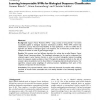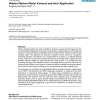85 search results - page 11 / 17 » Recognizing DNA Splicing |
CORR
2010
Springer
13 years 7 months ago
2010
Springer
Molecular recognition, which is essential in processing information in biological systems, takes place in a crowded noisy biochemical environment and requires the recognition of a ...
RECOMB
2005
Springer
14 years 8 months ago
2005
Springer
Background: Support Vector Machines (SVMs) ? using a variety of string kernels ? have been successfully applied to biological sequence classification problems. While SVMs achieve ...
BMCBI
2006
13 years 7 months ago
2006
Markov statistical methods may make it possible to develop an unsupervised learning process that can automatically identify genomic structure in prokaryotes in a comprehensive way...
BMCBI
2002
13 years 7 months ago
2002
Background: Total sequence decomposition, using the web-based MASIA tool, identifies areas of conservation in aligned protein sequences. By structurally annotating these motifs, t...
BMCBI
2008
13 years 7 months ago
2008
Background: Modern proteomes evolved by modification of pre-existing ones. It is extremely important to comparative biology that related proteins be identified as members of the s...


